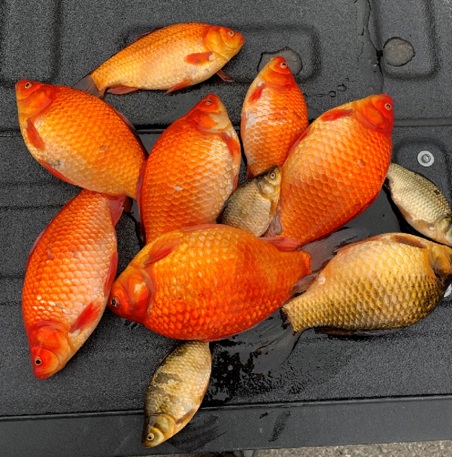Goldfish Mitigation
What are aquatic invasive species?
Aquatic invasive species (AIS) are non-native aquatic animals, plants or insects that have been brought from other places into Alberta’s lakes, ponds and waterways. Similar to other invasive species such as invasive weeds or insects, aquatic invasive species threaten and disrupt natural ecosystems and negatively impact biodiversity.
Invasive species of fish are being found across the province due to intentional or accidental introductions into Alberta waters. Aquarium owners and anglers can help prevent the introduction and spread of invasive fish.
Why are aquatic invasive species a problem?
These species have high potential to cause disastrous harm to our environment, economy, and human health as they become established outside their natural range. Typically threats include:
- increasing pressures on native species for resources including food, reproductive habitat and oxygen
- introduction of new parasites and disease to native species
- altering habitats so drastically that it becomes uninhabitable for native populations
Invasive species of all kinds are very difficult and costly to eradicate once they are established. Prevention, whenever possible, is essential.
What aquatic species are being found in our ponds?
- Common goldfish (Carassius auratus)
- Koi (Cyprinus rubrofuscus)
Why are goldfish considered invasive?
Goldfish and koi originate from Asia, where the climate is similar to Canada's, with this comes the ability to survive in water with extremely low oxygen, drastic swings in water temperature and high turbidity. They are also highly reproductive, with females having 3-5 broods each year, each time laying hundreds of eggs. With the population growing exponentially each season, they efficiently outcompete naturally occurring fish species for food and space.
Goldfish and koi dig around in the muddy bottom of ponds and lakes to find insects and other food sources, this activity creates murky or turbid water columns and impairs native fish species ability to forage and reproduce. Murky ponds don't allow for plants to grow within the water column, cause existing plant communities to die off and decay and the water to become more stagnant.
With no natural predators or parasites in North America, their populations can quickly grow out of control without human intervention. All ponds and lakes in Lethbridge overflow/drain to the storm water system, which is released directly into the Oldman River. 
How did they get in our ponds?
As goldfish and koi are not naturally occurring in North America, these fish were most likely introduced by well-meaning members of the public into the ponds around Lethbridge. We do not know exactly when they were added to the ponds, but they have been present for several years.
How do we mitigate invasive goldfish?
Currently, there is only one effective treatment for the eradication of invasive fish populations approved by the Government of Alberta. The use of a chemical called rotenone targets fish populations with no effect on pets or other wildlife. Rotenone is a naturally derived compound with a short half-life, meaning it will not remain in the water system for long and does not pose threat to anything other than fish.
For more information on rotenone click here.
The City of Lethbridge has identified established goldfish populations in 3 ponds in Lethbridge:
- Firelight Pond
- Chinook Lake
- Elma Groves Pond
The City of Lethbridge is working with a consultant and a licensed contractor to eradicate the goldfish in these ponds. Goldfish have been eradicated from Firelight Pond in 2022. In 2023, Chinook Lake and Elma Groves Pond will be eradicated.
Three phases have been outlined for this project:
- Investigation : This phase includes obtaining Fish Research License and site investigation to determine the size and quantity of fish. This portion of the work was completed for Firelight Pond in the fall of 2021.
- Planning and Procurement: This phase includes applying for environmental permits, and procurement of a qualified contractor for chemical application. Planning how the pond will be isolated, lowered and the steps required to prepare for the treatment will be outlined. The City will also be planning strategic public communications regarding the pond applications in the fall of 2022 and 2023.
- Mitigation : This phase includes a number of active steps and will be the most 'visible' parts of the project. Work to mitigate the goldfish population in Firelight Pond will include:
- A public communication plan including on site educational signage, neighbourhood announcements, media interviews and social media information.
- Site preparation: the ponds' water level will be decreased, the shoreline/access areas to the water will be fenced off and educational signage installed.
- Protective measures: the pond will be isolated from the storm system during the time of treatment and for 2-4 weeks after, so that in the event of a rain or snowfall, the pond will not release water and rotenone to the Oldman River.
- Application of rotenone by licensed chemical contractor.
- Clean up and disposal of fish carcasses and;
- Follow up reporting.
What can I do to help?
Never release aquarium species or water into any natural water bodies around Lethbridge, including storm water retention ponds. Unwanted aquarium pets in your home can be returned to local Pet Stores, or call AB Government 1-855-336-BOAT (2628) and they can assist you in the process.
Releasing fish or other aquatic species is illegal in Alberta, and can result in fines, or even jail time.
Contact Us
City Hall
910 4 Avenue South
Lethbridge, AB T1J 0P6
Phone: 311
or 403-320-3111 (if outside of Lethbridge)
